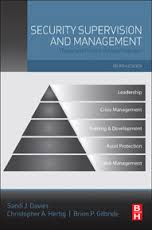Author: Edited by Sandi Davies
ISBN No: 9780128001134
Review date: 27/04/2024
No of pages: 668
Publisher: Butterworth Heinemann
Publisher URL:
http://store.elsevier.com
Year of publication: 29/07/2015
Brief:
Security Supervision and Management, fourth edition, edited by Sandi Davies, published 2015 by Butterworth-Heinemann. ISBN : 9780128001134, 668 pages, £39.09. Visit http://store.elsevier.com.
This weighty book, Security Supervision and Management, arises from the North America-based industry body IFPO, the International Foundation for Protection Officers – visit www.ifpo.org. The website’s ‘articles and reports’ section incidentally offers lots of free reading: http://www.ifpo.org/resource-links/articles-and-reports/.
For your money you do get plenty of reading, broken down into units which are each made up of several chapters. As the sub-title suggests, you get ‘Theory and Practice of Asset Protection’, which is not quite the same as safety (accident prevention) or security (loss prevention). Asset protection is defined early on as ‘an organisational management function responsible for preserving management’s capacity for achieving their purpose by defending the organisation, its assets and its relationships from non-market-based threats’. We’re talking, then, in terms of risk management; of protecting what you’ve got, and what you hope to profit from; like a shepherd shielding the flock from the wolves. That’s an interesting metaphor and image; how, we can wonder, does it tally with the corporate security view that security is part of doing business?
One early unit for example covers the ‘basics of supervision’ and is particularly welcome as supervisers – that level between officers and managers – is little-studied and written about, and indeed taken for granted as a stepping stone between the two, with elements of both. It’s surprising that we pay so little attention to front-line supervisers, arguably ‘the most important cog in the wheel’, because (as the unit soon points out) poor supervision can lead to contract or other failure. The unit covers the writing of policies; customer service; supervising crowds at events; and training (of officers, and hence themselves). The book goes on to recruitment (and retention); technology; emergency management; and investigations; and winds up with ‘current issues in security’. While the authors and their subjects are American, UK readers will recognise the ‘current issues’ of espionage, cyber, workplace violence, and standards. While wordy in parts , it’s a book to dip into if you are interested in any number of topics, from report writing (again, the superviser plays an important part here) to vehicle searches (’a legally complex activity’).
Security Supervision and Management, fourth edition, edited by Sandi Davies, published 2015 by Butterworth-Heinemann. ISBN : 9780128001134, 668 pages, £39.09. Visit http://store.elsevier.com.
Introduction
Protection Officer Code of Ethics
UNIT I: FOUNDATIONS
1. What is Asset Protection
2. Legal Aspects & Liability Issues
3. Crime and Deviance
4. Ethics, Integrity, and Professional Conduct
5. Risk Management
6. Accident Causation
7. Understanding the Supply Chain
UNIT II: BASICS OF SUPERVISION
8. Basics of Supervision
9. Supervisory Characteristics & Expectations
10. Corporate Policy & Procedures
11. Operational Supervision
12. Supervisor’s Role in Safety
13. Supervisor’s Role in Customer Service
14. Deploying Personnel
15. Planning and Supervising Special Events
UNIT III: TRAINING & DEVELOPMENT
16. Training and Development
UNIT IV: HUMAN RESOURCE MANAGEMENT
Part I – Human Capital
17. Recruitment, Retention and Selection of Security Personnel
18. Career Planning & Preparation
19. Orientation for Security Officers
20. Time and Stress Management
21. Employee Motivation Theory and Application
22. Supervising Across Different Cultures and Generations
23. Supervisor’s Role in Employee Relations
24. Personnel and Monitoring Employee Performance
Part II – Security – Related Business Functions
25. Basic Statistical Analysis
26. Relationship Between Marketing & the Security Function
27. Developing and Managing a Budget
28. Scheduling
29. Total Quality Management
30. Project Management
31. Standards & Guidelines
UNIT V: TECHNOLOGY IN SECURITY
32. Technology in Security
33. Access Control Systems
34. Closed Circuit/Digital Video Systems
35. Fire Protection Systems
36. Other Technologies (K-9, X-Ray, Radiation Detection, etc.)
37. Identification and Documents
UNIT VI: EMERGENCY MANAGEMENT
38. Incident Command System
39. Incident Management (Critical Incident Management in the Post 9/11 Era)
UNIT VII: INVESTIGATIONS
40. Managing Investigations
41. Conducting Interviews (Rapport-Based vs Adversarial)
42. Conducting a Search (Conveyances, Buildings, etc)
43. Crime Scene and Evidence Preservation
44. The Importance of Report Writing to the Security Operation
45. Detention & Apprehension Procedures
UNIT VIII: INFORMATION ASSURANCE
46. Industrial Espionage – A Primer
47. The Relationship Between Security and Corporate IT
48. Cyber Security
UNIT IX: CURRENT ISSUES IN SECURITY
49. Workplace Violence – Active Shooter
50. International Scene
51. Privacy









